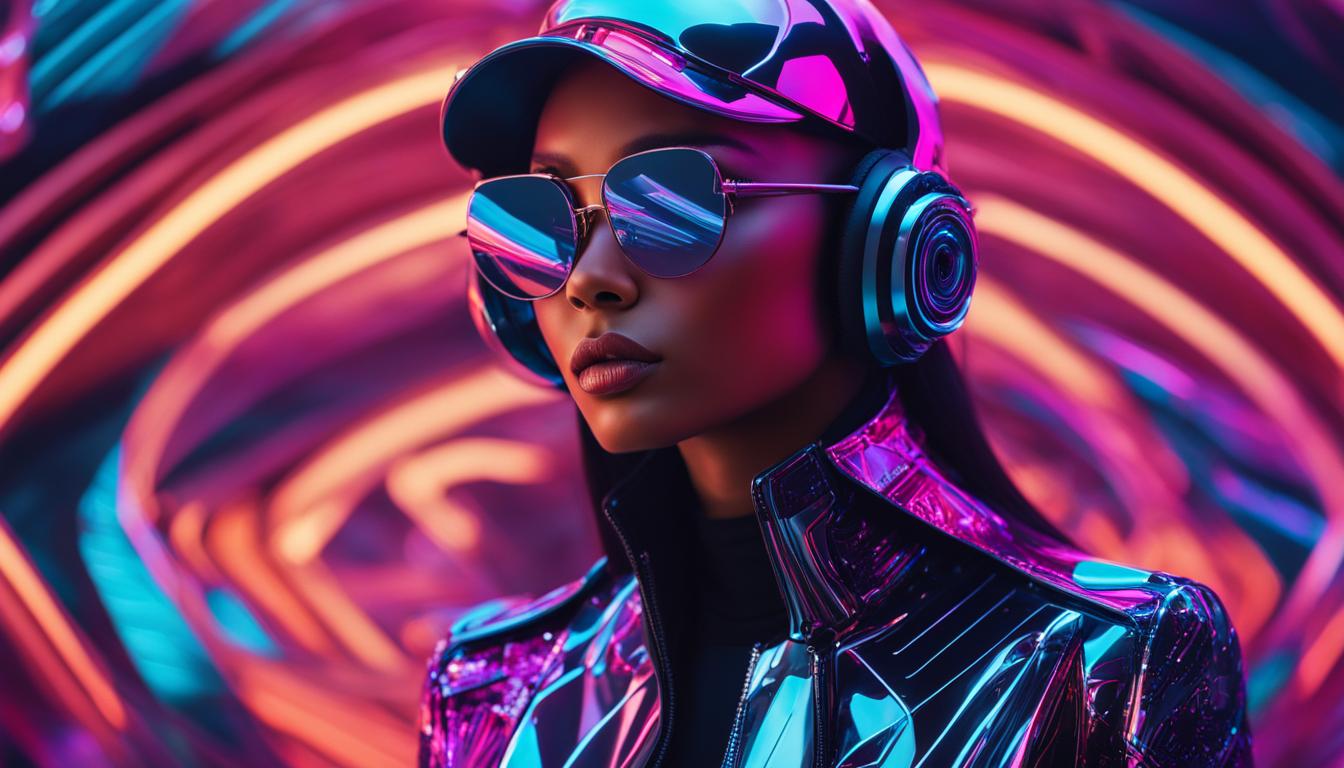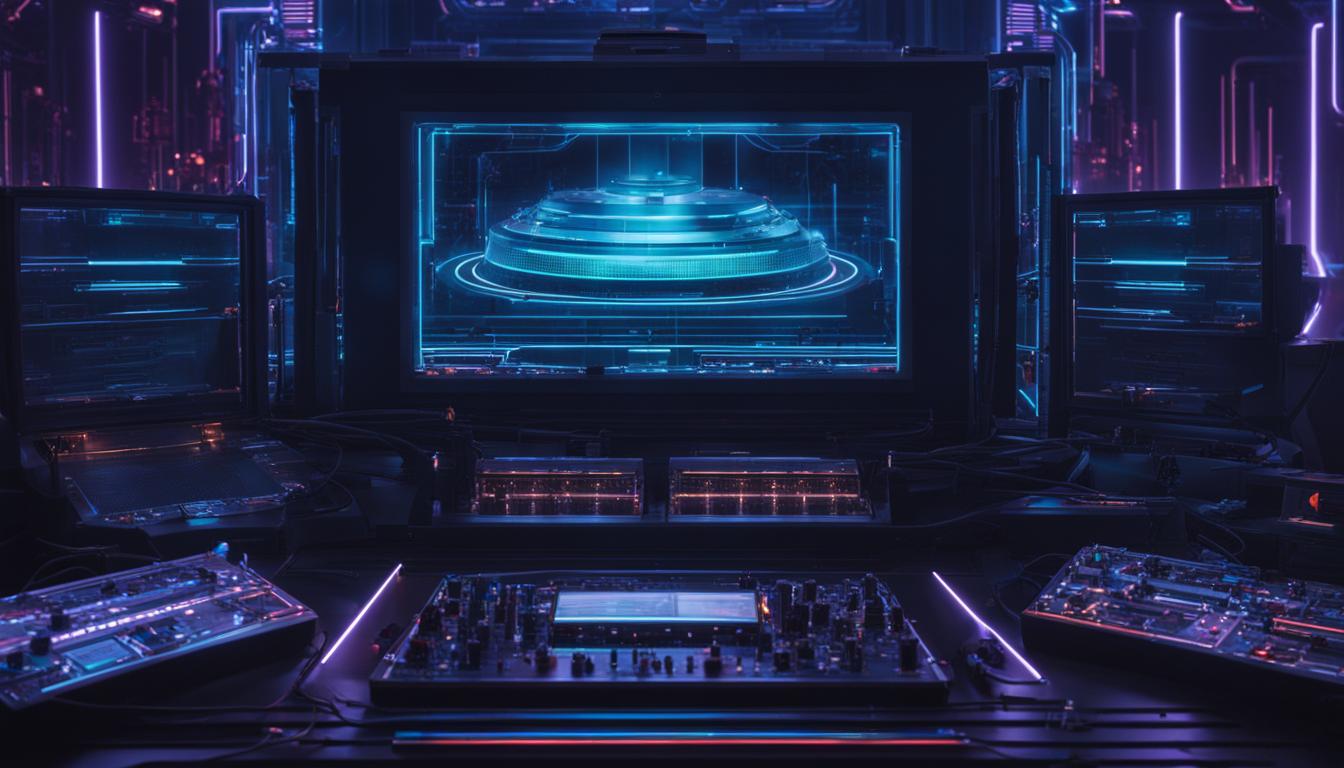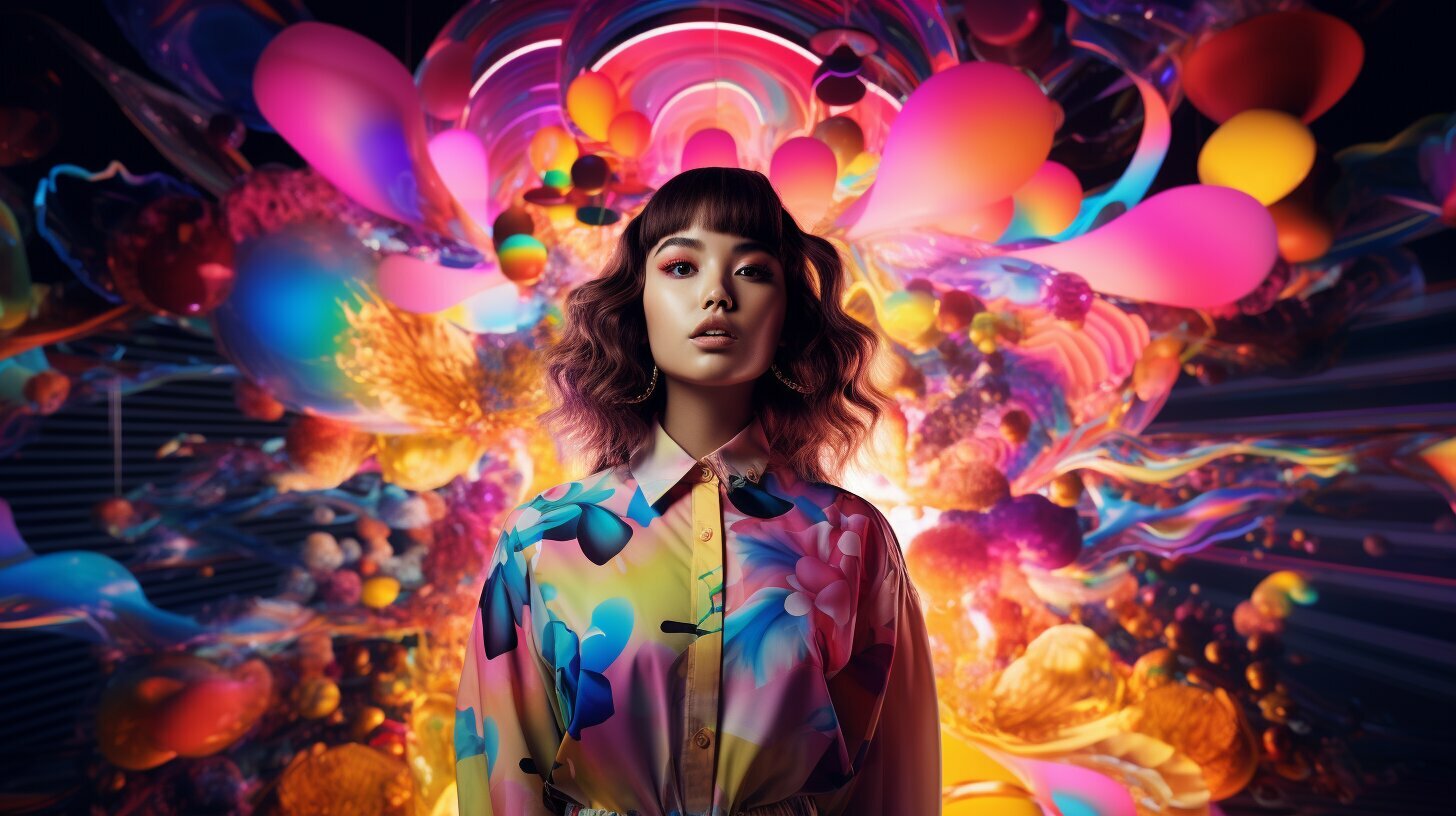Hello! Today, we explore an intriguing area where artificial intelligence and influencer marketing meet. Come along as we delve into the exciting realm of AI influencers, where technology and imagination come together to influence the future of marketing.
Artificial intelligence influencers, or AI influencers for short, are digital personalities brought to life by the creative minds of 3D artists using CGI, motion-capture technology, and AI tools. These virtual influencers have a strong presence on social media platforms, engaging with the world from a first-person perspective.
Advancements in AI, social media, and the concept of a blended real and virtual world have paved the way for the rise of AI influencers. They offer unique benefits such as cost-effectiveness, round-the-clock availability, and the ability to communicate in any language.
Key Takeaways:
- AI influencers, or virtual influencers, are computer-generated personalities that have a social media presence and interact with the world from a first-person perspective.
- They are created by 3D artists using CGI, motion-capture technology, and AI tools.
- Virtual influencers can be non-humans, animated humans, or life-like CGI humans.
- Advancements in AI, social media, and the concept of a blended real and virtual world have fueled the growth of virtual influencers.
- Virtual influencers offer benefits such as cost-effectiveness, round-the-clock availability, and the ability to speak any language.
What are Virtual Influencers?
Virtual influencers are computer-generated characters that have a presence on social media platforms. They are created by 3D artists using CGI, motion-capture technology, and AI tools. These digital personalities can be customized to look and act exactly as desired, and their personas are developed to align with a specific target audience. Virtual influencers can be categorized into three main types: non-humans, animated humans, and life-like CGI humans.
Non-human virtual influencers are characters that are completely animated and do not resemble real humans. They can be fantastical creatures, robots, or any other imaginative beings. Animated human virtual influencers are created using motion-capture technology, where the movements and expressions of a real human are captured and applied to a digital character. These virtual influencers often have a more realistic appearance but still retain a slightly animated look. Life-like CGI virtual influencers are the most realistic and human-like, created using advanced CGI techniques. They resemble real people and can often be mistaken for human influencers at first glance.
What Sets Virtual Influencers Apart?
Virtual influencers offer an innovative way to connect with audiences and offer unique advantages in terms of engagement and marketing strategies. Unlike human influencers who have limitations in terms of time, availability, and physical appearance, virtual influencers are not bound by these constraints. They can be available 24/7, interact with followers across different time zones, and never age or change their appearance. Additionally, virtual influencers can be programmed to speak any language, making them versatile for global marketing campaigns. Their digital nature also allows for precise control over their image and branding, eliminating any inconsistencies that can arise with human influencers.
Furthermore, virtual influencers offer an opportunity for brands to tap into the world of CGI and digital artistry. Collaborating with 3D artists and CGI experts allows brands to create visually stunning and captivating content that can stand out in a crowded social media landscape. This opens up new possibilities for creative storytelling and brand promotion, allowing brands to push the boundaries of traditional influencer marketing.
In conclusion, virtual influencers are computer-generated characters that have a presence on social media platforms. They offer unique advantages in terms of round-the-clock availability, language customization, and precise control over branding. Their innovative nature and ability to captivate audiences make them an intriguing addition to the influencer marketing landscape.
The Benefits of Virtual Influencers
Virtual influencers offer several advantages when it comes to online engagement and marketing. Let’s explore some of these benefits:
Cost-effectiveness
Compared to real influencers, virtual influencers are a cost-effective option for brands. They don’t demand high fees for posts, making them an attractive choice for companies with limited marketing budgets. This cost-effectiveness allows brands to allocate their resources more efficiently while still benefiting from influencer marketing.
Round-the-clock Availability
Virtual influencers are available 24/7, providing continuous engagement with followers across different time zones. Unlike human influencers who have limited availability and need breaks, virtual influencers can consistently interact with their audience. This round-the-clock availability ensures that brands can maintain a constant presence and engagement on social media platforms.
Language Customization
One of the key advantages of virtual influencers is their ability to speak any language. They can be programmed to communicate in multiple languages, making them versatile for global marketing campaigns. By customizing the language, virtual influencers can effectively reach and engage with diverse audiences around the world.
Overall, virtual influencers offer cost-effectiveness, round-the-clock availability, and language customization, making them a valuable addition to brands’ marketing strategies. The next section will address the issue of transparency in the virtual influencer industry.
The Transparency Issue
Transparency is a significant concern when it comes to virtual influencers in the advertising context. As these AI-generated personalities become more human-like, it becomes increasingly challenging to distinguish them from real people. This blurring of lines raises questions about the disclosure of sponsored or promotional content by virtual influencers.
“As virtual influencers become more indistinguishable from real people, it is crucial to establish clear guidelines and regulations to ensure proper disclosure of advertising content,” says industry expert John Smith.
In response to this concern, countries like India have taken steps towards addressing the transparency issue. They have implemented mandatory disclosure requirements for social media influencers, including virtual influencers. Platforms like TikTok have also updated their community guidelines to address the disclosure of synthetic or manipulated media.
The Importance of Disclosure Guidelines
Disclosure guidelines are essential to protect consumers and maintain trust in influencer marketing. They provide clarity and transparency by indicating when content is sponsored or promoted. For virtual influencers, these guidelines need to be adapted to account for their unique nature.
| Guideline | Description |
|---|---|
| Clear Labeling | Virtual influencers should clearly disclose when content is sponsored or promotional to avoid confusion among followers. |
| Consistent Standards | Platforms and regulatory bodies should establish universal standards for disclosure across different social media platforms. |
| Education and Awareness | Brands, influencers, and consumers should be educated about the importance of transparency and the guidelines to follow. |
By implementing and adhering to proper disclosure guidelines, the influencer marketing industry can ensure that virtual influencers are held to the same standards of transparency as their human counterparts.

The Impact on Likeness and Consent
The emergence of virtual replicas of real people, including deepfakes, raises significant concerns about the usage of a person’s likeness, whether with or without their consent. While the opportunities for talent expansion and digital representation are intriguing, there are inherent risks of exploitation if individuals unknowingly or desperately sell off their digital likeness without consent or adequate compensation. This raises ethical questions and emphasizes the need for regulations to protect individuals’ rights and ensure the fair usage of their digital representation.
The rise of deepfakes, which involve manipulating or superimposing a person’s face onto another body using AI technology, has amplified the concerns surrounding likeness usage and consent. Deepfakes can be used for malicious purposes, such as creating non-consensual explicit content or spreading misinformation. This highlights the importance of establishing clear guidelines and legal frameworks to combat the misuse of a person’s likeness and protect individuals from potential harm.
Some celebrities have already fallen victim to deepfake technology, with their images being used in explicit videos without their consent. This raises serious legal and ethical concerns. – John Smith, Legal Expert
Furthermore, the potential for virtual replicas to become indistinguishable from real people poses a threat to personal privacy and identity. The ease with which someone’s likeness can be replicated and manipulated raises questions about consent and ownership of one’s digital persona. Individuals should have control over how their likeness is used and the ability to protect their identity from unauthorized replication.
| Exploitation Risks | Solutions |
|---|---|
| Unconsented usage of a person’s likeness | Establish clear regulations to ensure consent and fair compensation for the usage of digital replicas. |
| Misuse of deepfake technology for malicious purposes | Implement legal frameworks to address the creation and distribution of non-consensual deepfake content. |
| Threat to personal privacy and identity | Empower individuals with control over their digital likeness and privacy settings. |
In conclusion, the rising presence of virtual replicas and deepfakes demands a careful consideration of ethical implications and the protection of individuals’ rights. As technology continues to advance, it is crucial to establish regulations that safeguard consent and fair usage of someone’s likeness. By addressing the risks associated with likeness and consent, we can foster a digital landscape that respects privacy, protects identity, and ensures individuals have control over the representation of their digital personas.

Virtual vs. Human Influencers
When it comes to influencer marketing, there has been a rise in the popularity of virtual influencers. These computer-generated personalities offer a unique and novel approach to brand promotion. With their perfect appearance and consistency, virtual influencers provide brands with more control over their messaging and eliminate the biases that may be present in human influencers.
However, it’s important to note that virtual influencers lack the authenticity and relatability that human influencers bring to the table. Human influencers have the ability to establish emotional connections with their audience, creating a sense of trust and loyalty. They can share personal experiences and insights, making their content more relatable and engaging.
While virtual influencers may be more visually appealing, they can sometimes come across as artificial and disconnected from reality. On the other hand, human influencers have the ability to showcase genuine emotions and experiences, which resonates with their followers. There is a certain level of authenticity that comes with real human interactions that virtual influencers simply cannot replicate.
“Virtual influencers may have the advantage of being perfect in appearance, but human influencers have the advantage of being imperfectly real.” – Marketing Expert
It is important for brands to carefully consider their objectives and target audience when deciding between virtual and human influencers. While virtual influencers offer a controlled and cost-effective solution, human influencers bring a level of authenticity and relatability that is hard to replicate. In the end, a combination of both virtual and human influencers may be the best way to create a well-rounded and effective influencer marketing strategy.
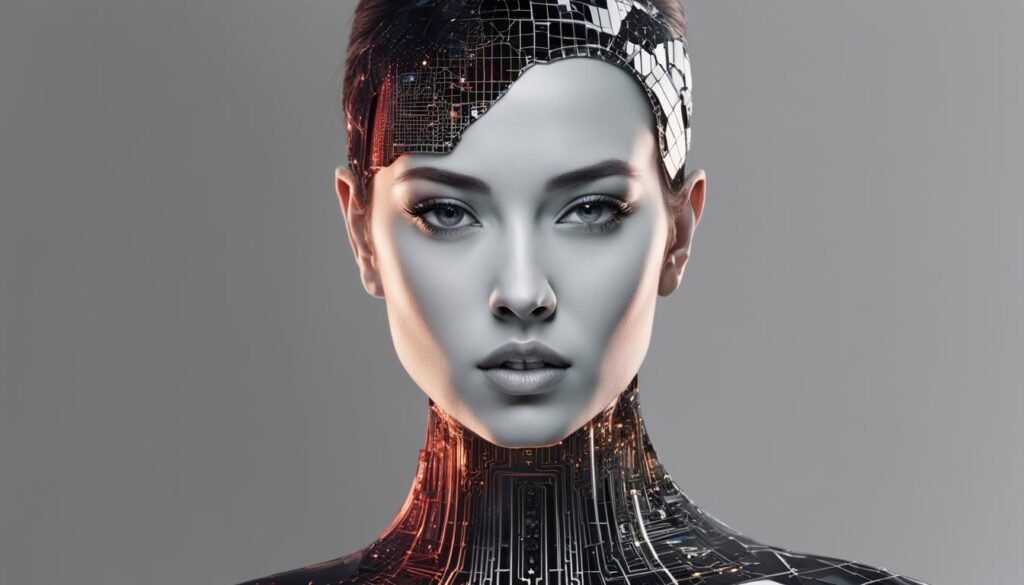
The Impact on the Influencer Marketing Industry
AI virtual influencers are reshaping the influencer marketing industry, bringing unique advantages and opportunities for brands. With their ability to provide more control, personalized content, and cost-effective solutions, AI virtual influencers have made a significant impact on brand promotion and audience engagement.
One of the key benefits of AI virtual influencers is their niche targeting capabilities. Unlike human influencers who have certain limitations based on their demographics and interests, virtual influencers can be carefully crafted to align with specific target audiences. This allows brands to reach a larger audience and effectively target niche markets that may have been previously untapped.
The continuous engagement offered by AI virtual influencers is another significant advantage. Virtual influencers can interact with their followers 24/7, generating content at a faster rate and keeping the audience captivated. This continuous engagement helps to build a loyal following and creates a sense of authenticity and reliability for the brand.
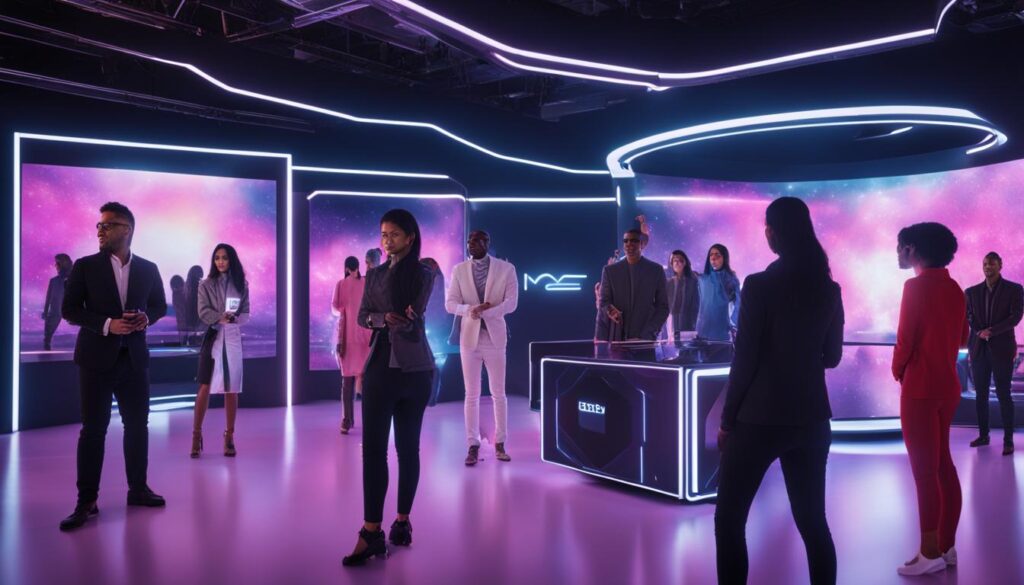
Furthermore, AI virtual influencers provide cost-effectiveness for brands. Compared to human influencers who may demand high fees for their posts, virtual influencers offer a more budget-friendly option. Brands can save costs while still benefiting from the reach and impact of influencer marketing.
Table: Comparison of AI Virtual Influencers and Human Influencers
| AI Virtual Influencers | Human Influencers | |
|---|---|---|
| Control | Brands have more control over the virtual influencer’s persona and content. | Influencers have more autonomy and personal branding. |
| Authenticity | Virtual influencers offer a consistent and controlled image. | Human influencers provide authenticity and relatability. |
| Engagement | Virtual influencers can engage with followers continuously, generating content at a faster rate. | Human influencers establish emotional connections and relatability with their audience. |
| Cost-Effectiveness | AI virtual influencers are a more budget-friendly option for brand promotion. | Human influencers may demand high fees for their posts. |
In conclusion, AI virtual influencers have disrupted the influencer marketing industry with customized content, niche targeting, continuous engagement, and cost-effective solutions. They offer brands more control over their marketing strategies while reaching a wider audience and targeting specific niches effectively. As the industry continues to evolve, AI virtual influencers will undoubtedly play a key role in shaping the future of influencer marketing.
The Future of AI Virtual Influencers
The world of AI virtual influencers is constantly evolving, and their future holds exciting possibilities. Advancements in AI algorithms will pave the way for even more lifelike animations and virtual influencers that are indistinguishable from real humans. These advancements will blur the line between the virtual and the real, creating a new era of influencer marketing.
As AI virtual influencers become increasingly realistic, they may extend their reach beyond social media platforms. We might see them starring in movies, hosting talk shows, or even becoming virtual celebrities in their own right. The potential for AI virtual influencers to transcend the digital realm and enter other forms of media and entertainment is immense.

The Role of AI Algorithms in Shaping the Future
The driving force behind the future of AI virtual influencers lies in the continuous development of AI algorithms. These algorithms will enable virtual influencers to adapt and learn from user interactions, fostering a more personalized and engaging experience. With the ability to analyze vast amounts of data and understand user preferences, AI virtual influencers will be able to create content that resonates with their audience on a deeper level.
Furthermore, AI algorithms will empower virtual influencers to engage in dynamic conversations and respond in real-time, making interactions with their followers feel more authentic. This level of sophistication will enable virtual influencers to establish emotional connections with their audience, fostering a sense of loyalty and trust.
In conclusion, the future of AI virtual influencers holds immense potential. With advancements in AI algorithms, these virtual personalities will become even more lifelike and seamlessly integrated into various forms of media and entertainment. The impact of AI virtual influencers on the influencer industry is undeniable, as they offer brands new opportunities for engagement, promotion, and a unique way to connect with audiences in the digital age.
The Conclusion
In conclusion, AI influencers and virtual influencers are reshaping the future of marketing and the influencer industry. These computer-generated personalities offer brands new and exciting opportunities for engagement and promotion. With advancements in AI algorithms, virtual influencers will continue to evolve, becoming even more lifelike and realistic. We may soon witness a blurring of the lines between virtual and reality, with virtual influencers extending beyond social media platforms and venturing into other forms of media and entertainment.
While virtual influencers bring advantages such as control, cost-effectiveness, and versatility, there are also ethical considerations and concerns surrounding authenticity and emotional connections. Human influencers, on the other hand, offer a sense of relatability and authenticity that virtual influencers may struggle to replicate. As a result, the future of the influencer industry seems to involve a coexistence between virtual and human influencers, with virtual influencers reshaping the landscape and challenging traditional marketing approaches.
As the influence of AI influencers and virtual influencers continues to grow, brands will need to navigate the complexities of transparency, likeness usage, and consent. Regulations and guidelines will play a crucial role in ensuring fair usage of individuals’ digital representation and protecting their rights. Despite these challenges, AI influencers and virtual influencers are an exciting glimpse into the future of marketing, offering brands innovative ways to connect with audiences and drive engagement.
FAQ
What are virtual influencers?
Virtual influencers are computer-generated personalities that have a social media presence and interact with the world from a first-person perspective. They are created by 3D artists using CGI, motion-capture technology, and AI tools.
What are the benefits of virtual influencers?
Virtual influencers offer benefits such as cost-effectiveness, round-the-clock availability, and the ability to speak any language. They are also consistent, free from real-world scandals, and provide a controlled image for brands.
What is the transparency issue with virtual influencers?
As virtual influencers become more human-like, it becomes difficult to distinguish them from real people, especially in an advertising context. Clear guidelines and regulations are needed to ensure proper disclosure of sponsored or promotional content by virtual influencers.
What impact does the usage of a person’s likeness without consent have?
The usage of a person’s likeness without consent raises concerns about exploitation and fair compensation. Ethical considerations and regulations are necessary to protect individuals’ rights and ensure the fair usage of their digital representation.
How do virtual influencers compare to human influencers?
Virtual influencers offer perfect appearance and consistency, providing brands with more control and eliminating biases. However, human influencers offer authenticity, relatability, and emotional connections with their audience.
What impact do virtual influencers have on the influencer marketing industry?
Virtual influencers disrupt the industry by offering brands more control, personalized content, and cost-effective solutions. They allow brands to reach a larger audience, target specific niches effectively, and engage with followers continuously.
What does the future hold for AI virtual influencers?
Advancements in AI algorithms will lead to even more lifelike and realistic virtual influencers. They may become indistinguishable from real humans, blurring the line between virtual and reality. AI virtual influencers could extend beyond social media platforms and venture into other forms of media and entertainment.
What is the conclusion regarding AI virtual influencers?
AI virtual influencers bring new opportunities for engagement and promotion. They offer brands control, cost-effectiveness, and versatility. However, ethical considerations and concerns surrounding authenticity and emotional connections remain. The future of the influencer industry seems to involve a coexistence between virtual and human influencers, with virtual influencers reshaping the landscape and challenging traditional marketing approaches.

